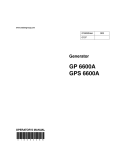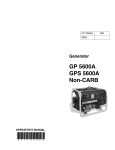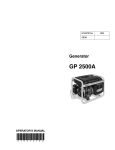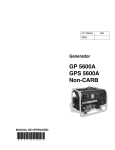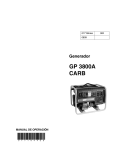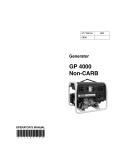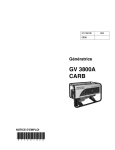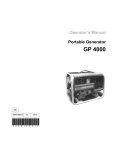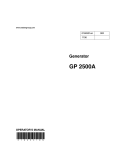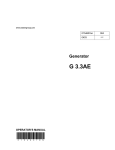Download Wacker Neuson GP 3800A Operator`s manual
Transcript
www.wackergroup.com 0160532en 0107 Generator GP 3800A OPERATOR’S MANUAL 0 1 6 0 5 3 2 E N 003 DANGER CARBON MONOXIDE Using a generator indoors CAN KILL YOU IN MINUTES. Generator exhaust contains carbon monoxide (CO). This is a poison you cannot see or smell. If you can smell the generator exhaust, you are breathing CO. But even if you cannot smell the exhaust, you could be breathing CO. • NEVER use a generator inside homes, garages, crawlspaces, or other partly enclosed areas. Deadly levels of carbon monoxide can build up in these areas. Using a fan or opening windows and doors does NOT supply enough fresh air. • ONLY use a generator outside and far away from windows, doors, and vents. These openings can pull in generator exhaust. Even when you use a generator correctly, CO may leak into the home. ALWAYS use a battery-powered or battery-backup CO alarm in the home. If you start to feel sick, dizzy, or weak after the generator has been running, move to fresh air RIGHT AWAY. See a doctor. You could have carbon monoxide poison. GP 3800A Table of Contents 1. Foreword 2. California Evaporative Emission Control Warranty Statement 6 3. Safety Information 3.1 3.2 3.3 3.4 3.5 3.6 4. 8 Laws Pertaining to Spark Arresters ...................................................... 8 Operating Safety .................................................................................. 9 Operator Safety while using Internal Combustion Engines ................ 11 Service Safety .................................................................................... 12 Label Locations .................................................................................. 13 Safety and Operating Labels .............................................................. 14 Technical Data 4.1 4.2 5. 5 18 Generator ........................................................................................... 18 Engine ................................................................................................ 19 Operation 5.1 5.2 5.3 5.4 5.5 5.6 5.7 5.8 5.9 5.10 5.11 5.12 5.13 5.14 5.15 5.16 5.17 20 Determining Power Requirements ..................................................... 20 Outdoor Installation ............................................................................ 21 Indoor Installation ............................................................................... 21 Wheel Kit ............................................................................................ 22 Generator Derating ............................................................................. 24 Grounding the Generator ................................................................... 25 Operating Heavy Loads ...................................................................... 25 Use of Extension Cords ...................................................................... 26 Control Panel ...................................................................................... 27 Ground Fault Interrupt (GFI) ............................................................... 28 Twist-Lock Receptacles ..................................................................... 28 Engine Auto Idle ................................................................................. 29 Engine Speed ..................................................................................... 29 Voltage Selection ............................................................................... 30 Before Starting ................................................................................... 31 To Start ............................................................................................... 32 To Stop ............................................................................................... 33 3 Table of Contents 6. GP 3800A Maintenance 6.1 6.2 6.3 6.4 6.5 6.6 6.7 6.8 6.9 6.10 6.11 6.12 6.13 6.14 6.15 34 Engine Maintenance ............................................................................34 Periodic Maintenance Schedule ..........................................................34 Engine Oil ............................................................................................35 Servicing Air Cleaner ...........................................................................36 Spark Plug ...........................................................................................37 Cleaning the Sediment Cup ................................................................38 Carburetor Adjustment ........................................................................38 Adjusting Engine Speed ......................................................................39 Storage ................................................................................................40 Transport .............................................................................................40 Troubleshooting ...................................................................................41 Wire Colors ..........................................................................................41 Electrical Schematic ............................................................................42 Electrical Schematic (CAN models only) .............................................44 Engine Schematic ...............................................................................46 wc_bo0160532en_003TOC.fm 4 WARNING 1. CALIFORNIA Proposition 65 Warning: Engine exhaust, some of its constituents, and certain vehicle components, contain or emit chemicals known to the State of California to cause cancer and birth defects or other reproductive harm. Foreword This manual provides information and procedures to safely operate and maintain this Wacker model. For your own safety and protection from injury, carefully read, understand and observe the safety instructions described in this manual. Keep this manual or a copy of it with the machine. If you lose this manual or need an additional copy, please contact Wacker Corporation. This machine is built with user safety in mind; however, it can present hazards if improperly operated and serviced. Follow operating instructions carefully! If you have questions about operating or servicing this equipment, please contact Wacker Corporation. The information contained in this manual was based on machines in production at the time of publication. Wacker Corporation reserves the right to change any portion of this information without notice. All rights, especially copying and distribution rights, are reserved. Copyright 2007 by Wacker Corporation. No part of this publication may be reproduced in any form or by any means, electronic or mechanical, including photocopying, without express written permission from Wacker Corporation. Any type of reproduction or distribution not authorized by Wacker Corporation represents an infringement of valid copyrights and will be prosecuted. We expressly reserve the right to make technical modifications, even without due notice, which aim at improving our machines or their safety standards. 5 California Evaporative Emission Control Warranty Statement 2. California Evaporative Emission Control Warranty Statement YOUR WARRANTY RIGHTS AND OBLIGATIONS The California Air Resources Board and Wacker Corporation, Inc. are pleased to explain the evaporative emission control system (EECS) warranty on your model year 2006 and later portable generator. In California, new portable generators must be designed, built and equipped to meet the State’s stringent anti-smog standards. Wacker Corporation must warrant the EECS on your portable generator for the period of time listed below provided there has been no abuse, neglect or improper maintenance of your portable generator. Your EECS on your model year 2006 and later portable generator includes the fuel line, fuel line clamps and fuel line fittings. Where a warrantable condition exists, Wacker Corporation will repair your portable generator at no cost to you including diagnosis, parts and labor. MANUFACTURER’S WARRANTY COVERAGE: This EECS is warranted for two years from the initial date of purchase. If any evaporative emission-related part on your equipment is defective, the part will be repaired or replaced by Wacker Corporation at no charge to you. The owner shall not be charged for diagnostic labor that leads to determination that a warranted part is in fact defective, provided that such diagnostic work is performed at a Wacker Corporation’s authorized service center. WARRANTY PERIOD: Any warranted part that is not scheduled for replacement as required maintenance, or which is scheduled only for regular inspection to the effect of “repair or replace as necessary” shall be warranted for two years. Any warranted part that is scheduled for replacement as required maintenance shall be warranted for a time not less than the remaining warranty period. 6 California Evaporative Emission Control Warranty Statement OWNER’S WARRANTY RESPONSIBILITIES: As the portable generator owner, you are responsible for performance of the required maintenance listed in your owner’s manual. Wacker Corporation recommends that you retain all receipts covering maintenance on your portable generator, but Wacker Corporation cannot deny warranty solely for the lack of receipts. As the portable generator owner, you should however be aware that Wacker Corporation may deny you warranty coverage if your portable generator or a part has failed due to abuse, neglect, or improper maintenance or unapproved modifications. You are responsible for presenting your portable generator to Wacker Corporation’s authorized service center as soon as the problem exists. The warranty repairs should be completed in a reasonable amount of time, not to exceed 30 days. If you have a question regarding your warranty coverage, you should contact your nearest authorized Wacker service center or call 1-800-770-0957. WHAT IS NOT COVERED: All failures caused by abuse, neglect, or improper maintenance are not covered. In addition, the use of add-on or modified parts will be grounds for disallowing a warranty claim. WARRANTED PARTS: The repair or replacement of any warranted part otherwise eligible for warranty coverage may be excluded from such warranty coverage if Wacker Corporation demonstrates that the portable generator has been abused, neglected, or improperly maintained, and that such abuse, neglect, or improper maintenance was the direct cause of the need for repair or replacement of the part. That notwithstanding, any adjustment of a component that has a factory installed, and properly operating, adjustment limiting device is still eligible for warranty coverage. The following emission warranty parts list is covered: (1)Fuel Line. (2)Fuel Line Clamps. (3)Fuel Line Fittings. 7 Safety Information 3. GP 3800A Safety Information This manual contains DANGER, WARNING, CAUTION, NOTICE and NOTE callouts which must be followed to reduce the possibility of personal injury, damage to the equipment, or improper service. This is the safety alert symbol. It is used to alert you to potential personal injury hazards. Obey all safety messages that follow this symbol to avoid possible injury or death. DANGER indicates a hazardous situation which, if not avoided, will result in death or serious injury. DANGER WARNING indicates a hazardous situation which, if not avoided, could result in death or serious injury. WARNING CAUTION indicates a hazardous situation which, if not avoided, could result in minor or moderate injury. CAUTION NOTICE: Used without the safety alert symbol, NOTICE indicates a hazardous situation which, if not avoided, could result in property damage Note: Contains additional information important to a procedure. 3.1 Laws Pertaining to Spark Arresters Notice: State Health Safety Codes and Public Resources Codes specify that in certain locations spark arresters be used on internal combustion engines that use hydrocarbon fuels. A spark arrester is a device designed to prevent accidental discharge of sparks or flames from the engine exhaust. Spark arresters are qualified and rated by the United States Forest Service for this purpose. In order to comply with local laws regarding spark arresters, consult the engine distributor or the local Health and Safety Administrator. 8 GP 3800A 3.2 Safety Information Operating Safety DANGER WARNING BACKFEED FROM THE GENERATOR INTO THE PUBLIC POWER DISTRIBUTION SYSTEM CAN CAUSE SERIOUS INJURY OR DEATH TO UTILITY WORKERS! Improper connection of generator to a building's electrical system can allow electrical current from the generator to backfeed into utility lines. This may result in electrocution of utility workers, fire, or explosion. Connections to a building's electrical system must be made by a qualified electrician and comply with all applicable laws and electrical codes. If connected to a building's electrical system the generator must meet the power, voltage, and frequency requirements of the equipment in the building. Differences in power, voltage, and frequency requirements may exist and improper connection may lead to equipment damage, fire, and personal injury or death. Familiarity and proper training are required for the safe operation of equipment. Equipment operated improperly or by untrained personnel can be dangerous. Read the operating instructions contained in both this manual and the engine manual and familiarize yourself with the location and proper use of all controls. Inexperienced operators should receive instruction from someone familiar with the equipment before being allowed to operate the machine. 3.2.1 NEVER operate the generator when open containers of fuel, paint, or other flammable liquids are near. 3.2.2 NEVER operate the generator, or tools attached to the generator, with wet hands. 3.2.3 NEVER use worn electrical cords. Severe electrical shock and equipment damage may result. 3.2.4 NEVER run the electrical cords under the generator, or over vibrating or hot parts. 3.2.5 NEVER enclose or cover the generator when it is in use or when it is hot. 3.2.6 NEVER overload the generator. The total amperage of the tools and equipment attached to the generator must not exceed the load rating of the generator. 3.2.7 NEVER operate the machine in snow, rain, or standing water. 3.2.8 NEVER allow untrained personnel to operate or service the generator. The generator set should be set up by a trained electrician. 3.2.9 NEVER stand on the machine. 3.2.10 DO NOT stand under the machine while it is being hoisted or moved. 3.2.11 DO NOT attach equipment to the machine when it is suspended. 9 Safety Information GP 3800A 3.2.12 ALWAYS store the equipment properly when it is not being used. Equipment should be stored in a clean, dry location out of the reach of children. 3.2.13 ALWAYS position and operate noncombustible, level surface. the generator on a firm, 3.2.14 ALWAYS transport the generator in an upright position. 3.2.15 ALWAYS keep the machine at least one meter (three feet) away from structures, buildings, and other equipment during use. 3.2.16 ALWAYS keep the area immediately surrounding and underneath the machine clean, neat, and free of debris and combustible materials. Make sure that the area overhead is clear of debris that could fall onto or into the machine or exhaust compartment. 3.2.17 ALWAYS remove all tools, cords, and other loose items from the generator before starting it. 3.2.18 ALWAYS make certain the machine is well-grounded and securely fastened to a good earthen ground per national and local regulations. 10 GP 3800A 3.3 Safety Information Operator Safety while using Internal Combustion Engines DANGER Internal combustion engines present special hazards during operation and fueling. Read and follow the warning instructions in the engine owner’s manual and the safety guidelines below. Failure to follow the warnings and safety guidelines could result in severe injury or death. 3.3.1 DO NOT run the machine indoors or in an enclosed area such as a deep trench unless adequate ventilation, through such items as exhaust fans or hoses, is provided. Exhaust gas from the engine contains poisonous carbon monoxide gas; exposure to carbon monoxide can cause loss of consciousness and may lead to death. 3.3.2 DO NOT smoke while operating the machine. 3.3.3 DO NOT smoke when refueling the engine. 3.3.4 DO NOT refuel a hot or running engine. 3.3.5 DO NOT refuel the engine near an open flame. 3.3.6 DO NOT spill fuel when refueling the engine. 3.3.7 DO NOT run the engine near open flames. 3.3.8 DO NOT start the engine if fuel has spilled or a fuel odor is present. Move the generator away from the spill and wipe the generator dry before starting. 3.3.9 ALWAYS refill the fuel tank in a well-ventilated area. 3.3.10 ALWAYS replace the fuel tank cap after refueling. 3.3.11 ALWAYS check the fuel lines and the fuel tank for leaks and cracks before starting the engine. Do not run the machine if fuel leaks are present or the fuel lines are loose. 11 Safety Information 3.4 GP 3800A Service Safety WARNING Poorly maintained equipment can become a safety hazard! In order for the equipment to operate safely and properly over a long period of time, periodic maintenance and occasional repairs are necessary. If the generator is experiencing problems or is being serviced, attach a “DO NOT START” sign to the control panel to notify other people of its condition. 3.4.1 DO NOT use gasoline or other types of fuels or flammable solvents to clean parts, especially in enclosed areas. Fumes from fuels and solvents can become explosive. 3.4.2 DO NOT attempt to clean or service the machine while it is running. 3.4.3 DO NOT modify the equipment without the express written approval of the manufacturer. 3.4.4 DO NOT allow water to accumulate around the base of the machine. If water is present, move the machine and allow the machine to dry before servicing. 3.4.5 DO NOT service the machine if your clothing or skin is wet. 3.4.6 DO NOT allow untrained personnel to service this equipment. Only trained electrical technicians should be allowed to service the electrical components of this equipment. 3.4.7 ALWAYS keep the machine clean and labels legible. Replace all missing and hard-to-read labels. Labels provide important operating instructions and warn of dangers and hazards. 3.4.8 ALWAYS replace the safety devices and guards after repairs and maintenance. 3.4.9 ALWAYS let the engine cool before transporting or servicing it. 3.4.10 ALWAYS keep hands, feet, and loose clothing away from the moving parts on the generator and engine. 3.4.11 ALWAYS turn the engine off before servicing the machine. If the engine has electric start, disconnect the negative terminal on the battery before servicing the machine. 3.4.12 ALWAYS keep the fuel lines in good condition and properly connected. Leaking fuel and fumes are extremely explosive. 12 GP 3800A Label Locations GND 13 88897 3.5 Safety Information Safety Information 3.6 GP 3800A Safety and Operating Labels Wacker machines use international pictorial labels where needed. These labels are described below: Label Meaning WARNING! Hot surface! CAUTION! Read and understand the supplied Operator’s Manuals before operating this machine. Failure to do so increases the risk of injury to yourself or others. CAUTION! Lifting point. GND 88897 Electrical ground 14 GP 3800A Label Safety Information Meaning Press circuit breaker switch to OFF position. Check the fuel level. Open the fuel flow valve. Press engine switch to ON position. GPS - Press ignition switch. GP - Pull the rewind starter. Press circuit breaker switch to ON position. Press engine switch to OFF position. 15 Safety Information Label GP 3800A Meaning Close the fuel flow valve. DANGER! Asphyxiation hazard. Read the operator’s manual for instructions. Use in a well-ventilated area. Do not use indoors or near open windows. Fumes can cause death. WARNING! To reduce the risk of electrical shock, read the operator’s manual. Improper connection of the generator to a building’s electrical system can allow electrical current from the generator to backfeed into utility lines. This may result in electrocution of utility workers, fire or explosion. Connections to a building’s electrical system must be made by a qualified electrician and comply with all applicable laws and electrical codes. A nameplate listing the model number, item number, revision number, and serial number is attached to each unit. Please record the information found on this plate so it will be available should the nameplate become lost or damaged. When ordering parts or requesting service information, you will always be asked to specify the model number, item number, revision number, and serial number of the unit. 16 GP 3800A Label Safety Information Meaning Important Emissions Information This equipment meets California EVP emission regulations for small off-road engines. This machine may be covered by one or more patents. DANGER! No sparks, flames or burning objects near machine. Shut off the engine before refueling. 17 Technical Data 4. GP 3800A Technical Data 4.1 Generator Item No. GP 3800A 0620010 GP 3800A CAN 0620041 Generator Maximum Output W 3800 Continuous Output W 3400 Type AC Voltages Available Frequency Dual voltage, single phase, Auto voltage regulator system 120 / 240 1ø volts phase 60 Hz Power Factor 1.0 AC receptacles: 125V GFI duplex 125V GFI duplex 125V twist-lock 125V/250V twist-lock amp amp amp amp 20 20 30 20 Main Circuit Breaker amp 2-pole, 16 amp each pole LxWxH mm (in.) 685 x 530 x 520 (27 x 21 x 20.5) Weight (dry) Kg (lbs.) 73 (160) 18 GP 3800A 4.2 Technical Data Engine Item No. GP 3800A 0620010 GP 3800A CAN 0620041 Engine Engine Type Single cylinder, 4-cycle, air-cooled, gasoline engine Engine Make Honda Engine Model GX 240 Rated Power 6 (8) kW (Hp) Spark Plug Electrode Gap BPR6ES / W20EPR-U 0.7–0.8 (0.028–0.031) mm (in.) Operating Speed (max.) rpm 3600 Air Cleaner type Dry type with oil-wetted foam pre-cleaner Engine Lubrication Engine Oil Capacity Fuel Fuel Tank Capacity Fuel Consumption Running Time oil grade SAE 10W30 service class SF, SE, SD or SC 1.1 (1.2) l (qts.) Regular unleaded gasoline type 19.5 (5.2) l (gal.) 2.4 (2.5) l (qts.)/hr. 8.2 hrs. 19 Operation 5. GP 3800A Operation 5.1 Determining Power Requirements This generator is designed to operate single-phase, 60 Hz appliances running at 120 VAC or 240 VAC. Check the nameplate or label provided on tools and appliances to make sure their power requirements match the power output of the generator. Some appliances and tools require a surge of current when starting. This means that the amount of power needed to initially start the equipment is larger than the power required to keep it running. The generator must be capable of supplying this “surge” current. Other types of appliances require more power than is actually stated on their nameplate. The information in “Approximate Starting Power Requirements” is offered only as a general guideline to help you in determining power requirements for different types of equipment. Check with your nearest Wacker Dealer, or contact the manufacturer or dealer of the tool or appliance, with questions regarding its power requirements. NOTICE: If a tool or appliance does not reach full speed within a few seconds when switched on, turn it off immediately to avoid damage. Approximate Starting Power Requirements • Incandescent lights and appliances such as irons and hot plates, which use a resistive-type heating element, require the same wattage to start and run as is stated on their nameplates. • Fluorescent and mercury lamps require 1.2–2 times their stated wattage to start. • Electrical motors and many types of electrical tools often require a large starting current. The amount of starting current depends on the type of motor and its use. • Most electrical tools require 1.2–3 times their stated wattage for starting. • Loads such as submersible pumps and air compressors require a very large force to start. They need as much as 3–5 times the wattage stated on the nameplate in order to start. If the wattage is not given for a particular tool or appliance, it can be calculated by multiplying its voltage and amperage requirements: Single Phase: VOLTS x AMPS = WATTS Three Phase: VOLTS x AMPS x 1.732 x 0.8 = WATTS 20 GP 3800A 5.2 Operation Outdoor Installation Place the generator in an area where it will not be exposed to rain, snow, or direct sunlight. Make sure it is positioned on firm, level ground, so it will not slide or shift. Position the engine exhaust away from areas where people may be present. If operating the generator inside a tunnel or deep trench, make sure there is adequate ventilation. Precautions similar to those required when operating indoors may be necessary. The surrounding area must be free from water and moisture. All components must be protected from excessive moisture. 5.3 Indoor Installation DANGER If the generator must be installed indoors, adequate ventilation or exhaust hoses must be provided. When venting exhaust fumes, make sure the exhaust piping is large enough to prevent excessive back pressure to the engine. Back pressure reduces engine efficiency and may cause the engine to overheat. Exhaust gas from the engine contains poisonous carbon monoxide gas; exposure to carbon monoxide can cause loss of consciousness and may lead to death. Never run the generator indoors or in an enclosed area unless adequate ventilation, through such items as exhaust hoses or fans, is provided. When installed indoors, steps to prevent fire and explosion such as providing a good, earthen ground, removing all flammable materials near the generator, and using only electrical cables in good condition, must be observed. See Operating Safety. 21 Operation 5.4 GP 3800A Wheel Kit See Graphic: wc_gr002658 The wheel kit (Part No. 0161308) is a standard item on Item Number 0620012, 0620015, 0620043 and 0620046 only. It is available as an option on all other models. 5.4.1 Hoist the generator, and align the axle (c) with the lower cross-member of frame. 5.4.2 Insert the axle brackets (k) over the axle and align the holes found in the axle bracket to the holes of the cross-member. Ensure that the brackets extend under the tube of the frame. 5.4.3 Insert M6 x 16 screws (l) through the outer holes on the cross-member, then through the holes of the axle bracket. 5.4.4 Insert M6 nuts (m) onto the screws and tighten. Torque to 7.5 Nm (5.25 ft.lbs.). 5.4.5 Assemble the washers (g) next to the rings (h), then add the wheels (d). 5.4.6 Add the washers (g) next to the wheels, then insert the pins (f) into the holes of the axle and separate the legs of the pins. 5.4.7 Align the holes found in the leg bracket (b) to the holes of the lower cross-member. 5.4.8 Insert M6 x 16 screws (l) through the outer holes on the cross-member, then through the holes of the leg bracket. 5.4.9 Insert M6 nuts (n) onto the screws and tighten. Torque to 7.5 Nm (5.25 ft.lbs.). 5.4.10 Insert M8 x 30 screw (o) through the hole in the leg bracket and through the hole in cross-member. 5.4.11 Insert M8 nut (p) onto the screw and tighten. Torque to 18.75 Nm (13.5 ft.lbs.). 5.4.12 Align the holes in the rubber foot mounts (e) to the holes of the leg bracket. 5.4.13 Insert M6 x 20 screws (m) through the leg bracket, then through the holes of the rubber foot mounts. 5.4.14 Insert the nuts (n) onto the screws and tighten. Torque to 7.5 Nm (5.25 ft.lbs.). 5.4.15 Align the holes found in the handles (a, j) to the holes of the brackets (1) on the frame. 5.4.16 Insert M6 x 16 screws (l) through the handles, then through the brackets on the frame. 5.4.17 Insert nuts (m) onto the screws and tighten. Torque to 7.5 Nm (5.25 ft.lbs.). 22 GP 3800A Operation 23 Operation 5.5 GP 3800A Generator Derating All generators are subject to derating for altitude and temperature. Internal combustion engines, unless modified, run less efficiently at higher altitudes due to the reduction of air pressure. This translates into a lack of power and thus reduction in generator output. Temperature affects both engine and generator performance. As temperature increases, an engine will run less efficiently and more resistance will be found in electrical components. Therefore, as the temperature increases, the output of the generator decreases. Altitude also affects the cooling capacity of air—the higher the altitude the less dense the air is and thus the lower its ability to transfer heat. For every increase in altitude of 500 m (1650 ft.) above 1000 m (3300 ft.), the output of the generator will be reduced by 3%. For every increase of 5° C (9° F) in ambient temperature above 40° C (104° F), the output of the generator will be reduced by 3%. Use the tables shown for altitude and temperature deration factors. It may be necessary to consider both altitude and ambient temperature deration factors to determine true generator output. Ambient Temp. °C (°F) Derate Factor 45 (113) 3% 0.97 50 (122) 6% 0.94 55 (131) 9% 0.91 60 (140) 12 % 0.88 Altitude m (ft.) Derate Factor 1500 (4900) 3% 0.97 2000 (6600) 6% 0.94 2500 (8200) 9% 0.91 3000 (9900) 12 % 0.88 3500 (11500) 15 % 0.85 4000 (13100) 18 % 0.82 24 GP 3800A 5.6 Operation Grounding the Generator See Graphic: wc_gr000544 A ground connection (a) is located on the generator frame. For proper operating safety, this ground terminal must be connected to a good ground source. This ground connection must comply with National Electrical Code standards, and state and local regulations. 5.7 Operating Heavy Loads Limit operations requiring the maximum rated output of 3800 W to 20– 30 minutes. For continuous operation do not exceed the continuous rated output of 3400 W. NOTICE: DO NOT exceed the current limit specified on the control panel for any receptacle. 25 Operation 5.8 GP 3800A Use of Extension Cords WARNING Current When a long extension cord is used to connect an appliance or tool to the generator, a voltage loss occurs—the longer the cord, the greater the voltage loss. This results in less voltage being supplied to the appliance or tool and increases the amount of current draw or reduces performance. A heavier cord with a larger wire size will reduce the voltage loss. Damaged extension cords can cause electrical shock, resulting in serious injury or death. DO NOT use worn, bare, or frayed cords. Replace damaged cords immediately. Use the chart below as a guide for selecting proper cable size. Load in Watts Maximum Cable Length in Feet (Amps) 120V 240V #10 #12 #14 #16 2.5 300 600 1000. 600 375 250 5 600 1200 500 300 200 125 7.5 900 1800 350 200 125 100 10 1200 2400 250 150 100 - 15 1800 3600 150 100 65 - 20 2400 4800 125 75 50 - Use only extension cords rated for outdoor use and equipped with a third-wire ground. NOTICE: Operating equipment at low voltage can cause it to overheat. 26 GP 3800A 5.9 Operation Control Panel See Graphic: wc_gr002327 Ref. Description Ref. Description a Engine switch g GFI test button b Auto idle switch h GFI reset button c Twist-lock receptacle—120V j Twist-lock receptacle—120/240V d Main circuit breaker m 20A circuit breaker (CAN only) e Voltage Selector Switch (VSS) n 30A circuit breaker (CAN only) f GFI duplex receptacle—120V 27 Operation GP 3800A 5.10 Ground Fault Interrupt (GFI) See Graphic: wc_gr002327 The two receptacles (f) are protected by a ground fault circuit interrupt (GFI). The GFI shuts off the power to the receptacle when a ground fault occurs in the generator or to a piece of equipment attached to the generator. The GFI should be tested for proper operation every time the generator is used. To test the GFI: Start the generator. Turn the auto idle “OFF”. Push the TEST button (h) on the receptacle in. The RESET button (g) will pop out. The power is now off at the receptacles. If the RESET button does not pop out, the GFI is not working. Do not run the generator until the problem can be corrected. To restore power to the receptacles, push the RESET button in. If the RESET button pops out during operation, stop the generator and check the generator and equipment for defects. 5.11 Twist-Lock Receptacles See Graphic: wc_gr002327 Twist-lock receptacles (c, j) are used at the 120V 30A and 120/240V 30A outlets. These receptacles are not protected by the GFI. To attach a power cord to a twist-lock receptacle, insert the plug into the receptacle and turn it clockwise to lock it in place. 28 GP 3800A Operation 5.12 Engine Auto Idle See Graphic: wc_gr002327 The auto idle switch (b) automatically reduces engine speed approximately 7 seconds after all appliances or tools attached to the generator have been turned off. The engine automatically returns to full speed when a tool or appliance is turned back on. To turn the auto idle feature on, push the auto idle switch to “AUTO”. The AUTO setting is recommended while the generator is running to minimize fuel consumption. To avoid extended engine warm-up periods, keep switch set to “OFF” when starting the engine and until the engine reaches operating temperature. 5.13 Engine Speed Generators require a fixed engine speed to maintain the correct voltage. Engine speed is controlled by a governor which automatically adjusts to varying loads on the engine to maintain a constant speed. See Technical Data. There is no throttle control. Use the Auto Idle switch on the generator to control engine speed. 29 Operation GP 3800A 5.14 Voltage Selection See Graphic: wc_gr002497 The voltage selector switch (e) allows the generator to operate in either single (120V) or dual voltage (120/240V) mode. In single-voltage mode, use only the 120V twist-lock (c) and duplex receptacles (f1, f2). The full rated power of the generator is shared between the three receptacles. In dual voltage mode both the 120V and 120/240V receptacles are powered; lower watts are available on receptacles (f1, f2, c). The 120/ 240V twist-lock receptacle (j) should be used in dual mode only. To achieve full power in this receptacle it should be used alone. NOTICE: NEVER switch the voltage selector switch with the main breaker on! This can cause arcing and can damage the generator. Turn all tools and appliances off and place main breaker (d) in the OFF position before changing voltage switch position. 30 GP 3800A Operation 5.15 Before Starting 5.15.1 Read and understand the safety and operating labels and instructions at the beginning of this manual 5.15.2 Inspect the generator for any signs of damage which may affect operation or pose a safety hazard. 5.15.3 Check: • oil level in engine • fuel level • condition of air cleaner • tightness of external fasteners • condition of fuel lines. Note: The engine is equipped with an oil alert system. If the oil level in the engine drops too low, the engine will not start. 5.15.4 Fill the fuel tank with fresh, regular, unleaded grade gasoline. DO NOT use an oil/gas mixture. The use of gasohol or any fuel containing more than 10% ethanol is not recommended. Consult the engine owner's manual for complete fuel specifications. 31 Operation GP 3800A 5.16 To Start See Graphic: wc_gr002499 Before starting, be sure you read and understand all the safety and operating instructions in this manual. 5.16.1 Disconnect all loads from the generator and place the main breaker in the "OFF" position (a2). 5.16.2 Set the Auto Idle Switch (c) to "OFF". 5.16.3 Open the fuel valve (d1). Note: If the engine is cold, move the choke lever to the closed position (e2). If the engine is hot, set the choke to the open position (e1). 5.16.4 Turn the engine switch to "ON" (b1). 5.16.5 Pull the starter rope (f). Note: If the oil level in the engine is low, the engine will not start. If this happens, check the oil level and add oil as needed. 5.16.6 As the engine warms up, move the choke lever to the OPEN position (e1). 5.16.7 Allow the engine to warm up for a few minutes before placing the main breaker in the "ON" position (a1) and attaching loads. 32 GP 3800A Operation 5.17 To Stop See Graphic: wc_gr002499 5.17.1 Turn off and disconnect all tools and appliances attached to the generator. 5.17.2 Place main circuit breaker in the "OFF" position (a2). 5.17.3 Turn the engine switch to "OFF" (b2). 5.17.4 Close fuel valve (d2). Note: To stop the engine quickly in an emergency, turn the engine switch to "OFF" (b2). 33 Maintenance 6. GP 3800A Maintenance 6.1 Engine Maintenance The chart below lists basic machine and engine maintenance. Refer to the engine manufacturer’s Operator’s Manual for additional information on engine maintenance. 6.2 Periodic Maintenance Schedule Daily before starting Check the fuel level. Check the engine oil level. Inspect the air filter. Replace as needed. Check external hardware. After first 20 hrs. Clean the air cleaner element.* Every 50 hrs. Every 100 hrs. Every 300 hrs. Inspect the shockmounts for damage. Change the engine oil.* Clean the sediment cup or fuel strainer. Check and clean the spark plug. Check and adjust the valve clearance. Clean the fuel tank.* Check condition of the fuel line. Replace when necessary. *Service more frequently in dusty conditions. 34 GP 3800A 6.3 Maintenance Engine Oil See Graphic: wc_gr000022 6.3.1 Drain the oil while the engine is still warm. 6.3.2 Remove the oil filler plug (a) and the drain plug (b) to drain the oil. Note: In the interests of environmental protection, place a plastic sheet and a container under the machine to collect any liquid that drains off. Dispose of this liquid in accordance with environmental protection legislation. 6.3.3 Install the drain plug. 6.3.4 Fill the engine crankcase with the recommended oil up to the level of the plug opening (c). See Technical Data for oil quantity and type. 6.3.5 Install the oil filler plug. 35 Maintenance 6.4 GP 3800A Servicing Air Cleaner See Graphic: wc_gr002815 Service the air cleaner frequently to prevent carburetor malfunction. NOTICE: NEVER run the engine without the air cleaner. Severe engine damage will occur. NEVER use gasoline or other types of low flash-point solvents for cleaning the air cleaner. A fire or explosion could result. WARNING To service: 6.4.1 Remove the air cleaner cover (a). Inspect the element (b) for holes or tears. Replace the element if it is damaged. 6.4.2 Wash the foam element (b) in a solution of mild detergent and warm water. Rinse it thoroughly in clean water. Allow the element to dry thoroughly. Soak the element in clean engine oil and squeeze out excess oil. 36 GP 3800A 6.5 Maintenance Spark Plug See Graphic: wc_gr000028 Clean or replace the spark plug as needed to ensure proper operation. Refer to the engine owner’s manual. The muffler becomes very hot during operation and remains hot for a while after stopping the engine. Do not touch the muffler while it is hot. WARNING Note: Refer to the Technical Data for the recommended spark plug type and the electrode gap setting. 6.5.1 Remove the spark plug and inspect it. 6.5.2 Replace the spark plug if the insulator is cracked or chipped. 6.5.3 Clean the spark plug electrodes with a wire brush. 6.5.4 Set the electrode gap (a). 6.5.5 Tighten the spark plug securely. NOTICE: A loose spark plug can become very hot and may cause engine damage. 37 Maintenance 6.6 GP 3800A Cleaning the Sediment Cup See Graphic: wc_gr000029 6.7 6.6.1 Turn the fuel valve off. 6.6.2 Remove the sediment cup (a) and the O-ring (b). 6.6.3 Wash both thoroughly in a nonflammable solvent. Dry and reinstall them. 6.6.4 Turn the fuel valve on and check for leaks. Carburetor Adjustment See Graphic: wc_gr000032 6.7.1 Start the engine and allow it to warm up to operating temperature. 6.7.2 Set the pilot screw (a) two turns out. See Note. 6.7.3 With the engine idling, turn the pilot screw (a) in or out to the setting that produces the highest rpm. 6.7.4 After the pilot screw is adjusted, turn the throttle stop screw (b) to obtain the standard idle speed. See Technical Data. Note: On some engines the pilot screw is fitted with a limiter cap (c) to prevent excessive enrichment of the air-fuel mixture in order to comply with emission regulations. The mixture is set at the factory and no adjustment should be necessary. Do not attempt to remove the limiter cap. The limiter cap cannot be removed without breaking the pilot screw. 38 GP 3800A 6.8 Maintenance Adjusting Engine Speed See Graphic: wc_gr000032 Generators require a fixed engine speed to maintain the correct voltage. Engine speed is controlled by a governor which automatically adjusts to varying loads on the engine to maintain a constant speed. There is no throttle control. To set the engine to the proper speed: Turn the speed adjusting screw (b) in or out to obtain a no-load speed. See Technical Data. NOTICE: Setting the engine speed too high or too low may damage tools and other appliances attached to the generator. 39 Maintenance 6.9 GP 3800A Storage Before storing the generator for a long period of time: 6.9.1 Close the fuel valve and remove and empty the sediment cup or fuel strainer. 6.9.2 Disconnect the fuel line from the carburetor. Place open end of fuel line into a suitable container and open fuel valve to drain fuel from tank. WARNING Gasoline is extremely flammable. Drain the fuel tank in a wellventilated area. DO NOT drain the fuel tank in an area with flames or sparks. 6.9.3 Loosen the drain screw on the carburetor and drain any remaining fuel from the carburetor. 6.9.4 Change the engine oil. 6.9.5 Remove the spark plug and pour approximately 30 ml (1 ounce) of clean engine oil into the cylinder. Crank the engine a few turns to distribute the oil to the inside of the cylinder walls. 6.9.6 Pull the starter rope slowly until resistance is felt and leave the handle in this position. This ensures that the intake and exhaust valves are closed. 6.9.7 Store the generator in a clean, dry area. 6.10 Transport Let the engine cool before transporting the generator or storing indoors, to avoid burns or fire hazards. WARNING When transporting the generator: 6.10.1 Turn the engine fuel valve to the OFF position. 6.10.2 Position the generator level to prevent fuel from spilling. 6.10.3 Secure the generator by tying it down with a suitable rope. WARNING When transporting the machine by hand, be sure to employ manpower commensurate with the weight of the machine. To avoid back injury when lifting the machine, bend the knees to pick it up rather than bending your back only. 40 GP 3800A Maintenance 6.11 Troubleshooting Problem / Symptom Reason / Remedy If engine doesn't start, check that: • Engine switch is on "Start". • Fuel valves under fuel tank and on engine are open. • Fuel tank has fuel. • Choke lever is in correct position. Choke should be closed when starting a cold engine. • All loads are disconnected from generator. • Spark plug is in good condition. • Spark plug cap is tight. • Engine oil level is adequate. If engine starts but there is no power at receptacles, check that: • Circuit breaker is closed. If engine starts but runs erratically, check that: • Hose routing from the fuel tank to the engine is correct. For proper operation, the hose must run through the bushing in the lifting bracket. Refer to the Parts Book for illustration. • Connector from generator to control panel is tight. 6.12 Wire Colors Wire Colors B Black R Red Y Yellow Or Orange G Green T Tan Br Brown Pr Purple L Blue V Violet Cl Clear Sh Shield P Pink W White Gr Gray LL Light blue 41 Maintenance GP 3800A 6.13 Electrical Schematic Ref. Description Ref. Description A Generator C Engine B Control box D Electric start engines Ref. Description Ref. Description 1 Main stator winding 1 11 Capacitor 2 Main stator winding 2 12 Engine ON / OFF switch 3 Auto idle unit 13 Rectifier 4 Main circuit breaker 14 Rotor winding/brushes 5 Voltage selector switch (120/240V position shown) 15 Secondary (excitation) winding 6 GFI duplex receptacle—120V 16 DC winding 7 Twist-lock receptacle—120V 17 Automatic voltage regulator (AVR) 8 Twist-lock receptacle—120/240V 18 15A fuse (GPS only) 9 Auto idle switch 19 Ignition switch (GPS only) 10 5A fuse 42 GP 3800A Maintenance 43 Maintenance GP 3800A 6.14 Electrical Schematic (CAN models only) Ref. Description Ref. Description A Generator C Engine B Control box D Electric start engines Ref. Description Ref. Description 1 Main stator winding 1 12 Engine ON / OFF switch 2 Main stator winding 2 13 Rectifier 3 Auto idle unit 14 Rotor winding/brushes 4 Main circuit breaker 15 Secondary (excitation) winding 5 Voltage selector switch (120V/240V position shown) 16 DC winding 6 GFI duplex receptacle—120V 17 Automatic voltage regulator (AVR) 7 Twist-lock receptacle—120V 18 15A fuse (GPS only) 8 Twist-lock receptacle—120/240V 19 Ignition switch (GPS only) 9 Auto idle switch 21 20A circuit breaker 10 5A fuse 22 20A circuit breaker (GP 3800 CAN only) 11 Capacitor 23 30A circuit breaker (GP 5600/6600 CAN only) 44 GP 3800A Maintenance 45 Maintenance GP 3800A 6.15 Engine Schematic See Graphic: wc_gr002580 Ref. Description Ref. Description A Generator D Wacker Engine B Control box E Honda Engine C Electric start engines (GPS) Ref. Description Ref. 1 Idle solenoid 6 Solenoid (GPS only) 2 Fuel cut solenoid 7 Starter (GPS only) 3 Oil alert module 8 Charging coil (GPS only) 4 Oil level switch 9 Battery (GPS only) 5 Coil 46 Description GP 3800A Maintenance 47 Maintenance GP 3800A Notes 48 Wacker Construction Equipment AG · Preußenstraße 41 · D-80809 München · Tel.: +49-(0)89-3 54 02 - 0 · Fax: +49 - (0)89-3 54 02-3 90 Wacker Corporation · P.O. Box 9007 · Menomonee Falls, WI 53052-9007 · Tel. : (262) 255-0500 · Fax: (262) 255-0550 · Tel. : (800) 770-0957 Wacker Asia Pacific Operations · Skyline Tower, Suite 2303, 23/F · 39 Wang Kwong Road, Kowloon Bay, Hong Kong · Tel. +852 2406 60 32 · Fax: +852 2406 60 21


















































